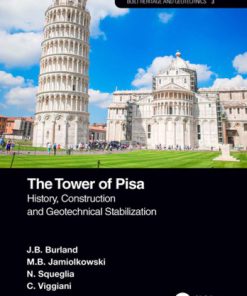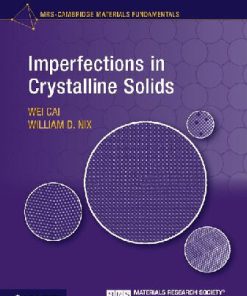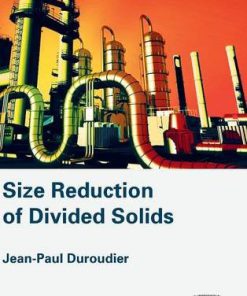The Physics of Solids 1st edition by Ketterson 9780191060564 0191060569
$50.00 Original price was: $50.00.$25.00Current price is: $25.00.
The Physics of Solids 1st edition by Ketterson – Ebook PDF Instant Download/Delivery: 9780191060564, 0191060569
Full download The Physics of Solids 1st edition after payment

Product details:
• ISBN 10:0191060569
• ISBN 13:9780191060564
• Author:Ketterson
The Physics of Solids
This comprehensive text covers the basic physics of the solid state starting at an elementary level suitable for undergraduates but then advancing, in stages, to a graduate and advanced graduate level. In addition to treating the fundamental elastic, electrical, thermal, magnetic, structural, electronic, transport, optical, mechanical and compositional properties, we also discuss topics like superfluidity and superconductivity along with special topics such as strongly correlated systems, high-temperature superconductors, the quantum Hall effects, and graphene. Particular emphasis is given to so-called first principles calculations utilizing modern density functional theory which for many systems now allow accurate calculations of the electronic, magnetic, and thermal properties.
The Physics of Solids 1st Table of contents:
Part I: Introductory Topics
1. Elastic Behavior of Solids
1.1 The stress tensor
1.2 The strain tensor
1.3 Hooke’s law
1.4 The energy density
1.5 Elastic moduli of cubic and hexagonal systems
1.6 Distortions of a cubic crystal
1.7 Elastic waves
1.8 Waves in a cubic crystal
1.9 Isotropic media
1.10 Viscosity in solids: internal friction
1.11 Measuring elastic constants
Supplementary Reading
Problems
2. Electric Behavior of Insulators
2.1 The potential from a distribution of dipoles: the polarization
2.2 The local electric field
2.3 The dielectric constant
2.4 Orientational polarization
2.5 Dielectric relaxation
Supplementary Reading
Problems
3. Metals and the Drude–Lorentz Model
3.1 Ohm’s law
3.2 The Hall effect
3.3 Frequency-dependent conductivity
3.4 Dielectric constant of a metal
3.5 Dielectric constant of an insulator
3.6 A metal in a constant magnetic field and an oscillatory electric field
3.7 Thermal conductivity in a metal
3.8 Thermoelectric effect
Supplementary Reading
Problems
4. Elementary Theories of the Thermal Properties of Solids
4.1 The equipartition law for free and bound particles
4.2 The lattice heat capacity at low temperatures: the Einstein model
4.3 The Debye model
Problems
5. Elementary Theories of Magnetism
5.1 Langevin diamagnetism
5.2 Langevin paramagnetism
5.3 Quantum theory of magnetism
5.4 Quantum theory of non-interacting spins
5.5 Adiabatic demagnetization
5.6 Chemical bonding, Hund’s rules, and magnetic ions
5.7 Magnetic moments of 4f and 3d ions
Further Readings
Problems
6. The Non-interacting Fermi Gas
6.1 The quantum mechanics of non-interacting electrons in a box
6.2 The non-interacting Fermi gas at absolute zero
6.3 Fermi–Dirac statistics
6.4 Evaluating integrals involving the Fermi distribution function
6.5 The temperature dependence of the chemical potential
6.6 Energy of an ideal Fermi gas as a function of temperature
6.7 The paramagnetic susceptibility of a Fermi gas
6.8 Qualitative discussion of the behavior of a Fermi gas
Problems
7. Elementary Theories of Crystal Bonding
7.1 Classification of bonds
7.2 The van der Waals bond: rare gas solids
7.3 The ionic bond: alkali halide solids
7.4 The directed covalent bond: Pauling orbitals
7.4.1 Diamond-like structures
7.4.2 Graphite
7.5 The alkali metal bond: the Wigner–Seitz model
7.6 Atomic radii
Additional Reading
Problems
Part II: Crystal Structure and its Determination
8. Lattices and Crystal Structures
8.1 The space lattice
8.2 The basis
8.3 Point groups in two dimensions
8.4 Bravais lattices in two dimensions
8.5 Space groups in two dimensions
8.6 Point groups in three dimensions
8.7 Bravais lattices in three dimensions
8.8 Crystal systems
8.9 Space groups in three dimensions
8.10 Common crystal structures
8.11 Miller indices
8.12 Wigner–Seitz polyhedra
8.13 Coordination polyhedra
9. X-ray Diffraction
9.1 Bragg’s law
9.2 The Laue equations
9.3 The reciprocal lattice
9.4 Relating the Laue equations to Bragg’s law
9.5 The Ewald construction
9.6 The Brillouin zone
9.7 The geometrical structure factor
9.8 The atomic scattering factor
9.9 The Debye–Waller factor
9.10 Sources of X-rays
9.11 Experimental methods to study X-ray diffraction
9.11.1 The rotating crystal method
9.11.2 The powder method
9.11.3 The Laue method
Additional Reading
Problems
Appendix 9A: Evaluating lattice sums by the Ewald method
Part III: Electronic Structure of Periodic Solids
10. Electrons in a Periodic Solid
10.1 The crystal potential
10.2 Wave function of an electron in a periodic potential
10.3 Properties of Bloch functions
10.3.1 Orthonormality
10.3.2 Periodicity in k-space; energy bands
10.3.3 The momentum operator and quasi-momentum
10.3.4 The position operator
10.3.5 The velocity operator
10.3.6 Effect of an external force
10.3.7 Scattering among Bloch states
10.4 Dispersion near a band edge
10.5 Electrons and holes
10.6 Brillouin zones
10.7 Wannier functions
10.8 The Kronig–Penney model
Additional Reading
Problems
11. The Nearly Free Electron, OPW, Pseudopotential, and Tight Binding Methods
11.1 The nearly free electron model
11.1.1 The empty lattice in one dimension
11.1.2 The nearly free electron model in one dimension
11.1.3 The nearly free electron model in two dimensions
11.1.4 The nearly free electron model in three dimensions
11.2 The orthogonalized plane wave method
11.3 The pseudopotential method
11.4 The tight binding approximation
11.4.1 The tight binding approximation for s electrons
11.4.2 The tight binding approximation for the case l>0
11.4.3 The tight binding approximation for the case l>0 together with a basis
Further Reading
Problems
12. The Parameterization of Band Structures: Applications to Semiconductors
12.1 The k⋅p method for diamond-like materials at the zone center
12.1.1 Spin–orbit coupling in atoms
12.1.2 Including spin in atomic s and p states
12.1.3 The k⋅p theory with spin
12.1.4 The symmetry of states in cubic crystals at the zone center
12.1.5 Basis functions for electrons in diamond-like materials at Γ
12.1.6 Constructing the Hamiltonian matrix
12.1.7 Calculating the dispersion
12.2 Inverted band structures; αSn
12.3 The Slater–Koster method for diamond-like structures
Further Reading
Problems
13. Augmented Plane Wave and Green’s Function Methods*
13.1 The augmented plane wave (APW) method
13.2 The Green’s function method
13.3 More powerful approaches: linearized variational methods
Additional Reading
Part IV: Electron–Electron Interaction
14. The Self-consistent Dielectric Function
14.1 The self-consistent potential method for a uniform electron system
14.2 Applications of the dielectric function formalism
14.2.1 Static screening; the Thomas–Fermi limit
14.2.2 Plasma oscillations
14.2.3 Zero sound
14.2.4 The Kohn effect
Additional Reading
Problems
Appendix 14A: The self-consistent potential method for the periodic system
15. Hartree–Fock and Density Functional Theory
15.1 The Hartree and Hartree–Fock approximations
15.1.1 The Hartree approximation
15.1.2 The Hartree–Fock approximation
15.1.3 The exchange energy of a uniform electron liquid
15.2 Density functional theory (DFT)
15.2.1 Local density theory
15.2.2 Potential energy landscape and the elastic constants of molecules
15.2.3 The Hohenberg–Kohn theorem
15.2.4 Application of density functional theory; Kohn–Sham theory
15.3 Alternative strategies based on density functional theory
15.3.1 The Hartree–Fock–Kohn–Sham (HFKS) approximation
15.3.2 The screened exchange approximation
15.3.3 Excited states
Further Reading
Problems
Appendix 15A: Multiple scattering theory
15A.1 Solution for a model potential
15A.2 Relating multiple scattering theory to the Kohn–Rostoker Green’s function method
Appendix 15B: The uniform electron liquid
15B.1 The Hellman–Feynman theorem
15B.2 The Coulomb interaction in terms of the number operator
15B.3 Linear response and the response function
15B.4 Relating the response function to the dielectric function
15B.5 Relating the dielectric function to the ground state energy
15B.6 The ground state energy from the SCF dielectric function
Part V: Lattice Dynamics
16. Harmonic Lattice Dynamics: Classical and Quantum
16.1 The 1d lattice
16.2 The 1d lattice with more than one atom per unit cell
16.3 Representing the lattice potential in 3d
16.4 Classical theory of the harmonic lattice in 3d
16.4.1 Normal modes and the dynamical matrix
16.4.2 Orthonormality and completeness relations
16.4.3 Lagrangian and Hamiltonian formulation
16.5 Quantization of lattice vibrations
16.6 Inelastic neutron scattering
16.7 Raman scattering
16.8 Calculating phonon dispersion relations from first principles
16.8.1 The supercell approach
Additional Reading
Problems
Appendix 16A: Calculating the phonon spectrum for all wave vectors
17. Thermal Expansion, Phonon–Phonon Interactions, and Heat Transport
17.1 Thermal expansion; the Gruneisen model
17.2 The linear term in the high temperature specific heat
17.2.1 The heat capacity of a single anharmonic oscillator
17.2.2 The linear term in the heat capacity of a lattice
17.3 Phonon–phonon interactions
17.4 The phonon Boltzmann transport equation
17.5 The thermal conductivity in dielectric materials
17.6 Second sound
Additional Reading
Part VI: Electron Transport and Conduction Electron Dynamics
18. Motion of Electrons and Holes in External Electric and Magnetic Fields
18.1 Incorporating external electromagnetic fields; gauge invariance
18.2 Effect of external magnetic and electric fields on Bloch functions
18.3 Quasiclassical equation of motion
18.4 Orbits in a magnetic field
18.5 Orbit quantization in a magnetic field
18.6 Magnetic breakdown
Additional Reading
Problems
Appendix 18A: Zener breakdown
19. Electronic Transport Properties Governed by Static Scattering Centers
19.1 The semi-classical approach: the distribution function
19.2 The Boltzmann equation
19.2.1 Evaluating the collision integral
19.2.2 The linearized Boltzmann equation
19.2.3 The relaxation time approximation
19.3 Electrical conductivity
19.4 Transport in the presence of electric fields and temperature gradients
19.5 Thermal conductivity
19.6 Thermoelectric effects
19.6.1 The Seebeck effect
19.6.2 The Peltier effect
19.7 Calculating thermoelectric coefficients
19.8 Magnetoresistance and the Hall effect
19.9 A two-band model
19.10 Calculation of the relaxation time
19.11 Limitations of the semi-classical theory
19.12 Time-dependent external fields; the Chambers path integral method
19.13 Collective excitations
Additional Reading
Problems
20. Measuring the Electronic Energy Spectrum On and Off the Fermi Surface
20.1 Determining the Fermi surface
20.1.1 The Lifshitz–Kosevich equation for the dHvA effect
20.1.2 Experimental techniques to measure the dHvA effect
20.1.3 Inversion of dHvA data and parameterization of the Fermi surface
20.1.4 Band structure based parameterization of the Fermi surface
20.1.5 Other methods to obtain Fermi surface information
20.2 Measuring the electronic excitation spectrum: ARPES and IPS
20.2.1 Analysis of ARPES data
20.2.2 Modeling finite lifetime effects below the Fermi energy
20.2.3 Inverse photo-emission spectroscopy
Additional Reading
21. The Interacting System of Metallic Electrons and Phonons
21.1 The dielectric function in the presence of a deformable positive background
21.2 Limiting forms; longitudinal sound
21.3 Phonon mediated electron–electron interactions
21.4 Formal theory of the electron–phonon matrix element
21.5 The phonon contribution to the low temperature electrical resistance
Additional Reading
Problem
Appendix 21A: The attenuation of sound by conduction electrons
21A.1 Longitudinal waves
21A.2 Transverse waves
Part VII: Semiconductors
22. Homogeneous Semiconductors
22.1 Model band structures
22.2 Parabolic bands
22.3 Carrier densities and densities of states
22.4 Band properties in some specific materials
22.5 Holes in Si and Ge
22.6 Impurity states
22.7 Calculating the occupancy of donors and acceptors
22.8 Carrier concentrations in the presence of donors and acceptors
22.8.1 High temperatures and low doping: the intrinsic regime
22.8.2 Intermediate temperatures and small charge imbalance: μ≅μi
22.8.3 Low temperatures
22.8.4 Very low temperatures
22.9 Impurity band conduction
22.10 Summary of the qualitative behavior on doping
Additional Reading
Problems
23. Inhomogeneous Semiconductors
23.1 The p–n junction in equilibrium
23.2 The p–n junction in the presence of an external electric field
23.3 A more detailed theory of the p–n junction
23.4 A survey of semiconductor devices
23.4.1 The diode rectifier
23.4.2 The p–n–p junction transistor
23.4.3 The tunnel diode
23.4.4 The junction laser
23.4.5 The Zener diode
23.4.6 The field effect transistor
23.4.7 The MOSFET
Additional Reading
Part VIII: Electric and Magnetic Properties of Insulators
24. Electric and Magnetic Susceptibilities
24.1 The static ionic polarizibility
24.2 Electronic polarizibility of atoms and molecules
24.3 The magnetic polarizibility of atoms and molecules
Additional Reading
25. Piezoelectricity, Pyroelectricity, and Ferroelectricity
25.1 Ferroelectricity and pyroelectricity
25.2 Landau theory of second-order ferroelectric transitions
25.3 The discontinuous ferroelectric transition: the first-order transition
25.4 The effect of an applied electric field on a ferroelectric; the susceptibility
25.5 Piezoelectricity
Additional Reading
Problem
Appendix 25A: Piezoelectric transducers
Part IX: Magnetism
26. Ferromagnetism and Antiferromagnetism
26.1 A survey of magnetic properties
26.1.1 Ferromagnetism
26.1.2 Antiferromagnetism
26.1.3 Ferrimagnetism
26.1.4 Complex structures
26.2 Density functional theory of band magnetism
26.3 The Landau model of ferromagnetism
26.4 The Weiss model of ferromagnetism
26.5 Anisotropy energy
26.6 The gradient energy
26.7 Surface tension of a domain wall
26.8 Ferromagnetic domains
26.9 Total magnetic free energy of a body
26.10 Single domain particles
26.11 The magnetization curve of an easy axis uniaxial ferromagnet
26.12 Measuring the magnetization
Additional Reading
Problems
27. Dynamic Properties of Magnetic Materials
27.1 The Landau–Lifshitz equation
27.2 Ferromagnetic resonance
27.3 Magnetic relaxation
27.4 Spin wave resonance
27.5 Antiferromagnetic resonance
27.6 Thermodynamic properties
27.7 The microscopic theory of magnons
27.8 Micromagnetics
27.8.1 Equilibrium magnetization of an arbitrarily shaped particle
27.8.2 The dynamic magnetic response in the linear regime
27.8.3 The direct approach
Additional Reading
Problems
Appendix 27A: Magnetostatic modes
27A.1 Damon and Eshbach theory of spin waves in a platelet
27A.2 Adding exchange
28. Magnetic Resonance28
28.1 Electron spin resonance (ESR) and nuclear magnetic resonance (NMR)
28.2 Relaxation effects
28.3 Spin echoes
28.4 Nuclear quadrupole resonance
28.5 The quantum mechanical expression for energy dissipation
28.6 The chemical and Knight shifts
Further Reading
Appendix 28A: Dipolar broadening
Appendix 28B: Microscopic theory of spin–lattice relaxation; the Korringa relation
28B.1 Nuclear Zeeman level transitions induced by electrons
28B.2 Relaxation effects
28B.3 Spin echoes
Part X: Optical Properties
29. Optical Responses
29.1 The matrix element for optical absorption spectra
29.2 Critical points in the optical absorption
29.3 The frequency-dependent susceptibility
29.4 Some analytic properties of the susceptibility
29.5 The Kramers–Kronig relations
29.6 Some examples of optical absorption spectra
Additional Reading
Problems
30. Polaritons, Excitons, and Plasmons
30.1 The optical phonon–polariton
30.2 Excitons
30.2.1 Wannier excitons
30.2.2 The Frenkel exciton
30.3 The exciton–polariton
30.4 Plasmons
30.5 Surface polaritons
Additional Reading
Problems
31. Behavior Under Intense Illumination: NLO, the e–h Liquid and Excitonic BEC
31.1 The nonlinear susceptibility
31.2 Effects of χ(2) and χ(3) on harmonic fields
31.3 Collective effects in semiconductors under intense illumination
31.4 The electron–hole liquid
31.5 Bose condensation in an ideal gas
31.6 The weakly interacting Bose gas
31.7 The weakly interacting Bose gas for non-zero temperatures
31.8 The Gross–Pitaevskii equation
31.9 Polaritons in a 2d photonic cavity
31.10 BEC of exciton–polaritons in two dimensions
Additional Reading
Part XI: Superconductivity and Superfluidity
32. A Phenomenological Theory of Superconductivity: The London Equations
32.1 The superconducting state
32.2 The London equations
32.3 Thermodynamics of a type I superconductor
32.4 The intermediate state
32.5 Surface energy between a normal and a superconducting metal
32.6 Quantized vorticity
32.7 Type II superconductivity
32.8 Superconducting magnets
Additional Reading
33. A Phenomenological Theory of Superconductivity: The Ginzburg–Landau Theory and the Josephson Effects
33.1 Ginzburg–Landau theory
33.1.1 Basic equations
33.1.2 Gauge invariance
33.2 Boundaries and boundary conditions
33.2.1 The pinned boundary and the coherence length
33.2.2 The London equation and the penetration depth
33.2.3 The normal-metal/superconductor phase boundary; the G–L surface tension
33.2.4 Superconductors in contact when a current is present
33.3 The upper critical field and the phase diagram of a type II superconductor
33.4 The Josephson effects
33.4.1 The Josephson equations
33.4.2 Magnetic field effects: the two-junction SQUID
33.4.3 The extended Josephson junction
Additional Reading
Problem
34. The Microscopic Theory of Superconductivity: Cooper Pairing and the Bardeen–Cooper–Schrieffer Theory
34.1 Pairing of two electrons above a filled Fermi sea
34.2 The Bardeen–Cooper–Schrieffer superconducting ground state
Additional Reading
Problem
Appendix 34A: Some calculations involving the BCS wave function
35. Elementary Excitations and the Thermodynamic Properties of Superconductors
35.1 The Bogoliubov–Valatin transformation
35.2 Thermodynamic properties
35.3 The pair amplitude and the order parameter
Additional Reading
36. Superfluid ⁴He
36.1 Landau’s phenomenological model for ⁴He
36.2 Superfluidity
36.3 The two-fluid model
36.4 The thermo-mechanical effect
36.5 Hydrodynamics of superfluids and sound propagation
36.5.1 Second sound
36.5.2 First sound and the equations of motion
36.5.3 Fourth sound
36.6 The Landau–Ginzburg theory of ⁴He
36.7 Quantized vorticity
Problem
Additional Reading
37. Landau’s Theory of a Fermi Liquid
37.1 Equilibrium properties
37.1.1 The challenge
37.1.2 Basic ideas
37.1.3 The quasiparticle interaction function
37.1.4 Sum rules
37.2 Collisionless collective modes
37.2.1 The kinetic equation
37.2.2 Collisionless longitudinal zero sound
37.2.3 Collisionless transverse zero sound
Additional Reading
Problems
Appendix 37A: Collisionless spin waves in ³He
38. Superfluid ³He
38.1 Basic ideas
38.2 The generalized order parameter of a superfluid
38.3 Rotation properties of the order parameter
38.4 Ginzburg–Landau theory of the superfluid phases of ³He
38.5 Minimization of the free energy for an l=1, s = 1 superfluid
38.6 Anisotropy of the energy gap in an l=1, s = 1 superfluid; order parameter of ³He
Additional Reading
Problem
Part XII: Disordered Materials
39. Alloys
39.1 Phase equilibrium
39.1.1 Phases in contact: the Gibbs phase rule
39.1.2 Binary mixtures
39.1.3 The chemical potential of a dilute alloy
39.1.4 Characteristic binary phase diagrams
39.1.5 Examples of phase diagrams
39.2 Order–disorder transitions
39.3 The isolated charged impurity: the Friedel sum rule
39.4 The electronic structure of alloys
39.4.1 The virtual crystal approximation
39.4.2 The average T-matrix approximation (ATA)
39.4.3 The coherent potential approximation (CPA)
39.4.4 The supercell approach
Additional Reading
Problem
40. Defects and Diffusion in Crystalline Solids
40.1 Point defects
40.2 Concentration of point defects
40.3 Point defects in lattices with more than one species
40.4 Diffusion: microscopic theory
40.5 Diffusion: macroscopic theory
40.6 Temperature dependence of the diffusion constant
40.7 Ionic conduction
40.8 Color centers
40.8.1 The F center: a vacancy bound electron
40.8.2 Additional color centers
Further Reading
41. Dislocations and Grain Boundaries
41.1 The edge dislocation
41.2 The screw dislocation
41.3 The continuum theory of the dislocation displacement field
41.3.1 Continuum elasticity theory of the isolated screw dislocation
41.3.2 Continuum elasticity theory of the isolated edge dislocation
41.4 Grain boundaries
Additional Reading
Problems
42. Quantum Theory of Electrical Transport in Dilute Alloys
42.1 The vector potential as a time-dependent perturbation
42.2 Relation between the current density and the vector potential
42.3 Case of a uniform electric field: the local conductivity
42.4 A non-local model
42.5 A free electron density matrix with scattering: the Bardeen ansatz
42.6 The Chambers path integral
Additional Reading
Problem
Appendix 42A: Zero-frequency response; Landau diamagnetism
43. Electrical Transport in Highly Disordered Media: Localization/Interaction Effects
43.1 Temperature dependence of the electrical resistivity of a highly doped semiconductor: strong localization
43.2 Temperature dependence of the electrical resistivity of a disordered metal and an alloy: weak localization
43.3 Electrical transport via hopping; strong localization
43.4 Weak localization
43.5 Magnetoresistance and the Aharonov–Bohm effect
43.6 The experiment of Yu. Sharvin and D. Sharvin
43.7 Quantization effects in mesoscopic systems
43.8 Localization meets superconductivity
Additional Reading
Problem
44. Magnetic Impurities and their Interactions: The Anderson Model, the Kondo Effect, and the RKKY Interaction
44.1 The Anderson Hamiltonian
44.2 The mean-field theory
44.2.1 Case Vkd=0, U≠0
44.2.2 Case Vkd≠0, U=0
44.2.3 Case Vkd≠ 0,U≠ 0
44.3 The s–d exchange model
44.4 The Kondo effect: electrical resistance versus temperature from paramagnetic impurities
44.5 Polarization of conduction electrons by an embedded spin; the RKKY interaction
44.5.1 Conduction electron polarization
44.5.2 The RKKY interaction
44.6 Spin glasses
Additional Reading
Problems
Appendix 44A: Kondo’s second-order perturbation theory calculation
44A.1 Calculating the transition rate
44A.2 Calculating the conductivity
Part XIII: Special Topics
45. Strongly Correlated Systems
45.1 The Mott insulator and the Mott transition
45.1.1 A simple model
45.1.2 A more realistic model
45.1.3 Incorporating the p states
45.2 The LDA implementation of DFT
45.2.1 An LDA + U implementation of DFT without orbital polarization
45.2.2 Generalized m-dependent Coulomb interactions; orbital polarization
45.3 Strongly correlated electrons in metals
45.3.1 A brief survey of some heavy fermion properties
45.3.2 Physical effects underlying heavy fermion behavior
45.4 Quantum phase transitions and marginal Fermi liquids
45.5 Possible mechanisms underlying heavy fermion superconductivity
Supplementary Reading
46. High Temperature Superconductors
46.1 The discovery of cuprate superconductors
46.2 Some phenomenology of cuprate superconductors
46.3 Electronic structure of cuprates
46.4 Model Hamiltonians
46.5 Doping
46.6 Determining the Fermi surface of cuprates
46.7 Josephson coupled layered systems
46.7.1 The Lawrence–Doniach model
46.7.2 The upper critical fields
46.7.3 Finite layer thicknesses
46.7.4 An isolated vortex for the field parallel to the layers
46.7.5 An isolated vortex for the field perpendicular to a thin film: the pancake vortex
46.7.6 An isolated vortex for the field perpendicular to a stack of layers
46.8 Vortex matter and phase diagrams
46.9 Non-cuprate high temperature superconductors
46.10 Historical evolution of superconducting transition temperatures
Supplementary Reading
47. Artificially Structured and Patterned Materials; Surfaces and Interfaces
47.1 Artificially layered materials
47.2 Artificial superlattices
47.3 Multilayer semiconductors
47.4 Quantum wells; modulation doping
47.5 Multiple wells and superlattices
47.6 Metallic multilayers
47.6.1 Superconducting multilayers
47.6.2 Magnetic multilayers
47.7 Spin tunneling
47.8 Spin torque oscillators
47.9 Surface states
47.10 Atoms at a free surface; reconstruction
47.11 Calculating surface and interface electronic properties
47.12 The chemical potential; the work function
47.13 Methods to measure the work function
47.13.1 The photoelectric effect
47.13.2 Thermionic emission
47.13.3 The Kelvin method
47.14 Electron affinity; work function of a semiconductor
Additional Reading
Problems
48. The Quantum Hall Effects
48.1 The integer quantum Hall effect
48.1.1 The phenomenon
48.1.2 An electron in two dimensions in a magnetic field: rectangular coordinates
48.1.3 A two-dimensional electron gas in a magnetic field
48.1.4 Motion under orthogonal electric and magnetic fields
48.1.5 Quantization of the Hall voltage: qualitative considerations
48.1.6 An electron in two dimensions in a magnetic field: cylindrical coordinates
48.1.7 Edge states
48.1.8 Localized states
48.2 The fractional quantum Hall effect
48.2.1 A semi-empirical accounting for observed filling fractions
48.2.2 Many-body ground states for non-interacting electrons in the lowest Landau level
48.2.3 Flux tubes
48.2.4 Adding flux tubes to the non-interacting many-body ground state wave function
48.2.5 Trial ground states for the fractional quantum Hall effect
48.2.6 The ν = 1/2 state
Additional Reading
Problems
49. Graphene, Carbon Nanotubes, and Fullerenes
49.1 The electronic structure of graphene
49.2 Graphene multilayers
49.3 The band structure of graphene from ARPES
49.4 Graphene in a magnetic field
49.5 The Shubnikov-de Haas and quantum Hall effects in graphene
49.6 Single-walled nanotubes
49.7 Fullerenes
Additional Reading
Problems
Appendix A: The Calculus of Variations
A.1 The Euler–Lagrange equations and the mechanics of particles
A.2 Extension of the Euler–Lagrange formalism to continuum fields
Appendix B: The Symmetry of Many–Particle Wave Functions; The Occupation Number RepresentationB
B.1 The symmetry of two-particle wave functions
B.2 The symmetry of many-particle wave functions
B.3 Separation of spatial and spin coordinates in a many-particle system
B.4 Interactions in many-particle systems
B.5 Occupation number representation: Bose statistics
B.6 Occupation number representation: Fermi statistics
B.7 Time-dependent formalism
B.8 Constructing many-particle state functions from vacuum state functions
B.9 Performing calculations in the occupation number representation
Problems
Index
People also search for The Physics of Solids 1st:
the physics of solids 1st edition
the physics of stars phillips pdf
the physics of star wars pdf
the physics of stars pdf
the physics of wall street pdf
You may also like…
Relationships & Lifestyle - Psychological Self-Help
Technique - Construction
Romance - Paranormal Romance
My Beautiful Monsters 02.0 – Monster Song 1st Edition J.B. Trepagnier
Romance - Paranormal Romance
My Beautiful Monsters 03.0 – The Call of Monsters 1st Edition J.B. Trepagnier











